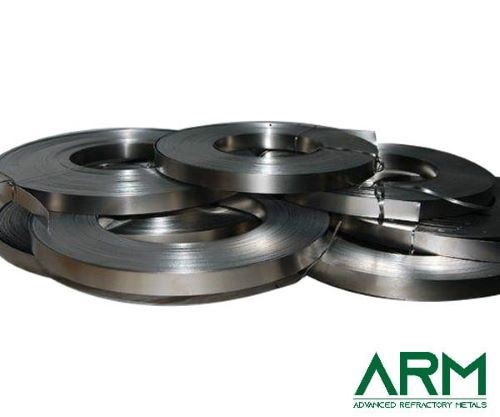Something You Need to Know about Molybdenum Strip

Introduction to Molybdenum Strip
Molybdenum strip is well-known for their resistance to heat and corrosion, and they are widely used in a number of applications and fields. Advanced Refractory Metals (ARM) is a global supplier of molybdenum products. We offer molybdenum products of various shapes and sizes at a competitive price within a short lead time. Customized products are also welcome.

The Element—Molybdenum
Molybdenum (Mo, atomic number: 42) is located at Block D, Group 6, Period 5 in the periodic table. It is the 54th most abundant element in the earth's crust. Molybdenum is not a free metal. A majority of molybdenum comes from its ore molybdenite (molybdenum disulfide, MoS2). Due to its soft black look, molybdenite was thought to contain lead, and it was once confused with graphite and used to make pencils. Molybdenum can also be obtained from the byproduct of copper and tungsten mining. Molybdenum element was not discovered until 1778 by Carl Scheele. The metal was isolated later in 1781 by Peter Jacob Hjelm. Since then, molybdenum came into the world and began to be applied to a range of fields thereafter.
Features of Molybdenum Strips
- Basic information: Molybdenum is a grayish hard metal with a Mohs hardness of 5.5 and a standard atomic weight of 95.95 g/mol. For more information about our molybdenum strips, please check Table 1 below.
- Physical properties: Molybdenum is famous for its high melting point of 2,623 °C (4,753 °F). Naturally, only tantalum, tungsten, and carbon have higher melting points than molybdenum.
- Chemical properties: Molybdenum is a transition metal. Its electronegativity is 2.16 on the Pauling scale. That means it does not react with oxygen or water at room temperature.
In a word, molybdenum possesses unique strength, and resistance to corrosion and high temperatures, so it is suitable for a number of applications and industries where high heat resistance is needed.
Table 1 MU1417 Molybdenum Strip (Mo Strip)
| Catalog No. | MU1417 |
| Size | 0.03-0.08 x 2.0-6.0 x L (in coil) |
| Material | Mo≥99.95% & TZM |
| Standard | ASTM B386 |
| Density | 9.8 – 10.2 g/cc |
| Surface | Cold Rolling |
Applications of Molybdenum Strips
Alloy
Most molybdenum is used to produce alloys. Adding molybdenum to alloys can increase their hardness, electrical conductivity, and resistance to wear and corrosion. Molybdenum alloys are used in engines, heating elements, drills, and saw blades. Among them, about 80% of molybdenum is used in steel alloys.
Additionally, molybdenum is sometimes used to replace tungsten for its low price. It is also used as a flame-resistant coating for other metals because molybdenum oxidizes quickly at temperatures above 760 °C, which makes it more suitable for vacuum environments. TZM is a molybdenum super-alloy containing 99% Mo, 0.5% Ti, 0.08% Zr, and some C. This alloy is about twice as strong as pure molybdenum and is more ductile. All properties of these alloys are enhanced due to the addition of molybdenum.
Lighting
Lighting is one of the earliest application fields for molybdenum. This metal has high strength and resistance to high temperature and corrosion and was usually used with tungsten. Its low price and compatibility with tungsten also make it the perfect choice for the lighting industry. Over time, the lighting industry has made higher requirements, such as high melting-point glass envelopes, and molybdenum is a perfect fit for the lamp envelope because of its thermal expansion coefficiency.
Semiconductor
Molybdenum is also used to make equipment that produces semiconductors and solid-state devices. Its strength and stiffness at high temperatures and resistance to aggressive environments make it an ideal option for components in ion implantation equipment used to produce semiconductors. It also finds use in other equipment like molecular beam epitaxy and physical vapor deposition equipment.
Other Applications
- Molybdenum is used in a range of products because of its high-temperature resistance. Typical applications for this metal include crucibles, evaporation boats, the lighting industry, glass-melting electrodes, high-temperature furnaces, heating elements, electrodes, stirrers, orifice plates, support members, mandrels, shields, sintering trays, filaments, furnace windings, nozzles, jet tabs, contacts, brazing fixtures, boring bars, tools, heat radiation shields, cathodes, and aircraft and missile parts.
- Small amounts of molybdenum can be found in missiles, engine parts, drills, saw blades, lubricant additives, ink for circuit boards, and protective coatings in boilers.
- “Big Bertha”, the German 43-ton gun used in World War II, used molybdenum as an essential component of its steel because of its much higher melting point.
Conclusion
Advanced Refractory Metals (ACM) is a leading supplier of different kinds of molybdenum products. We have a variety of molybdenum products, including sheets, plates, rods, bars, alloys, and compounds. We use 99.95% molybdenum powders and vacuum heat treatment to ensure a high density and great quality of our molybdenum strips. These strips are treated with careful handling and packing to avoid damage during storage and transportation. For detailed information, please check the table below.
Table 2 Specifications of Molybdenum Strip
| Thickness | Tolerance | Width | Tolerance |
| >0.01-0.03 | ±0.002 | >1-3 | ±0.10 |
| >0.03-0.06 | ±0.003 | >3-6 | ±0.15 |
| >0.06-0.10 | ±0.004 | >6-10 | ±0.25 |
| >0.10-0.15 | ±0.005 | >10-15 | ±0.40 |
| Chemical Composition | Tensile Strength (σb.MPa) | Elongation (δ.%) | Hardness (HV50G.Mbar) |
| Molybdenum>99.9% | >690 | >1.5 | <2900> |
{{item.content}}
LEVE A REPLY
{{item.children[0].content}}
{{item.content}}






